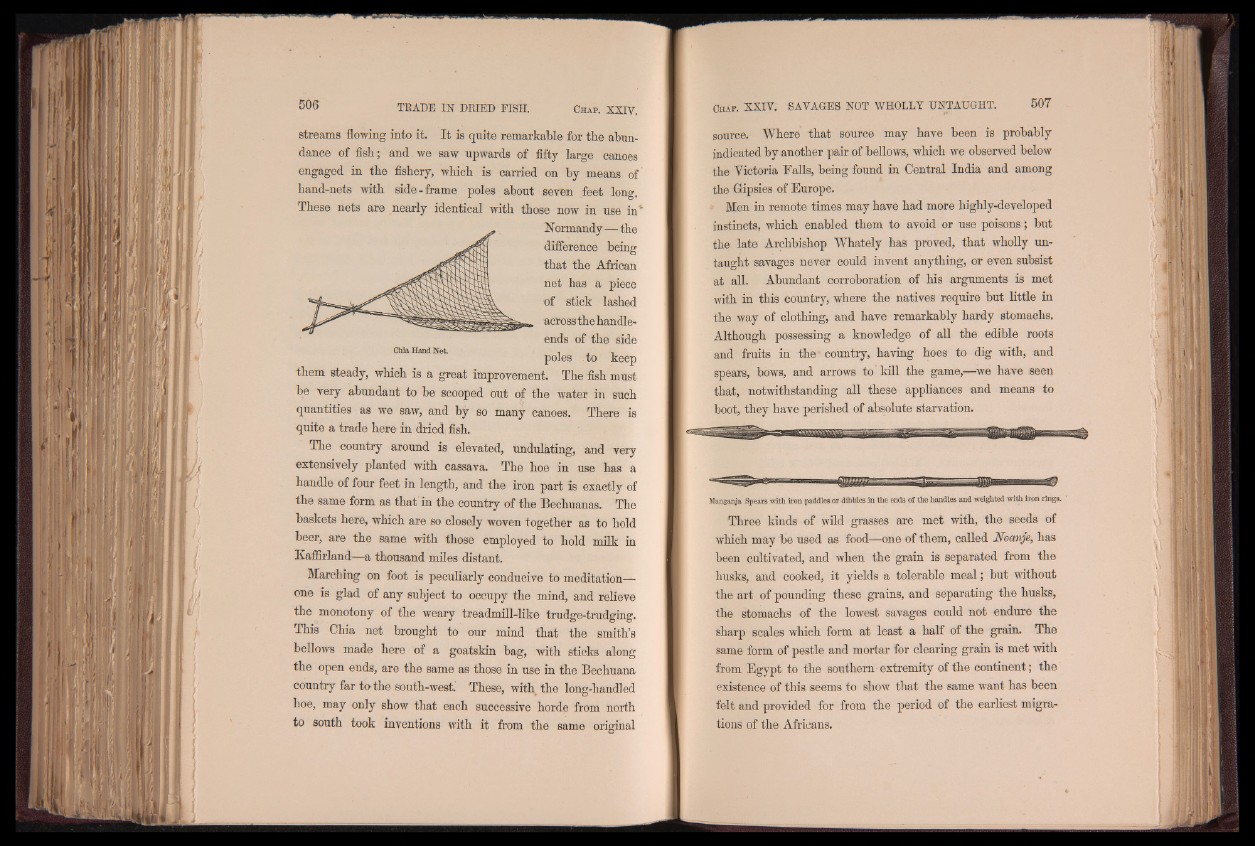
streams flowing into it. I t is quite remarkable for the abundance
of fish; and we saw upwards of fifty large canoes
engaged in the fishery, which is carried on by means of
hand-nets with side-frame poles about seven feet long.
These nets are nearly identical with those now in use in1
Normandy — the
difference being
that the African
net has a piece
of stick lashed
across the handle-
ends of the side
Chla Hand Net. i . , poles to keep
them steady, which is a great improvement. The fish must
be very abundant to be scooped Out of the water in such
quantities as we saw, and by so many canoes. There is
quite a trade here in dried fish.
The country around is elevated, undulating, and very
extensively planted with cassava. The hoe in use has a
handle of four feet in length, and the iron part is exactly of
the same form as that in the country of the Bechuanas. The
baskets here, which are so closely woven together as to hold
beer, are the same with those employed to hold milk in
KafiSrland—a thousand miles distant.
Marching on foot is peculiarly conducive to meditation-
one is glad of any subject to occupy the mind, and relieve
the monotony of the weary treadmill-like trudge-trudging.
This Chia net brought to our mind that the smith’s
bellows made here of a goatskin bag, with sticks along
the open ends, are the same as those in use in the Bechuana
country far to the south-west. These, with the long-handled
hoe, may only show that each successive horde from north
to south took inventions with it from the same original
source. Where that source may have been is probably
indicated by another pair of bellows, which we observed below
the Victoria Palls, being found in Central India and among
the Gipsies of Europe.
Men in remote times may have had more highly-developed
instincts, which enabled them to avoid or use poisons; but
the late Archbishop Whately has proved, that wholly untaught
savages never could invent anything, or even subsist
at all. Abundant corroboration of his arguments is met
with in this country, where the natives require but little in
the way of clothing, and have remarkably hardy stomachs.
Although possessing a knowledge of all the edible roots
and fruits in th e1 country, having hoes to dig with, and
spears, bows, and arrows to kill the game,—we have seen
that, notwithstanding all these appliances and means to
boot, they have perished of absolute starvation.
Manganja Spears with iron paddles or dibbles in the ends of the handles and weighted with iron rings.
Three kinds of wild grasses are met with, the seeds of
which may be used as food—one of them, called Noanje, has
been cultivated, and when the grain is separated from the
husks, and cooked, it yields a tolerable meal; but without
the art of pounding these grains, and separating the husks,
the stomachs of the lowest savages could not endure the
sharp scales which form at least a half of the grain. The
same form of pestle and mortar for clearing grain is met with
from Egypt to the southern extremity of the continent; the
existence of this seems to show that the same want has been
felt and provided for from the period of the earliest migrations
of the Africans.